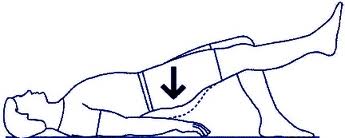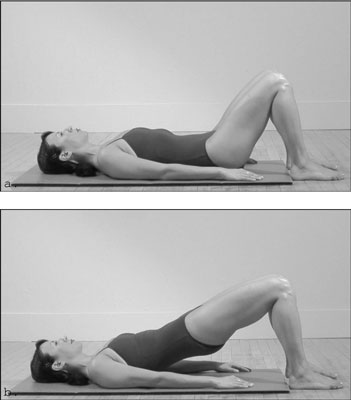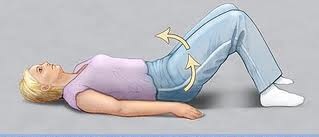Bridging: Difference between revisions
Kim Jackson (talk | contribs) No edit summary |
No edit summary |
||
| Line 12: | Line 12: | ||
Individuals with back and [[Hip Osteoarthritis|hip pathologies]] are often taught to perform the bridging exercise in the crook-lying position, elevating the pelvis off the floor. This exercise is particularly useful for facilitating pelvic motions and strengthening the low back and hip extensors, and it enhances motor control of the [[Lumbosacral Biomechanics|lumbo-pelvic region]].<ref name="eun mi">Eun-Mi Jang, Mi-Hyun Kim,Jae-Seop Oh. Effects of a Bridging Exercise with Hip Adduction on the EMG Activities of the Abdominal and Hip Extensor Muscles in Females. Journal of Physical Therapy Sciences, 2013; 25:1147–1149.</ref><br> | Individuals with back and [[Hip Osteoarthritis|hip pathologies]] are often taught to perform the bridging exercise in the crook-lying position, elevating the pelvis off the floor. This exercise is particularly useful for facilitating pelvic motions and strengthening the low back and hip extensors, and it enhances motor control of the [[Lumbosacral Biomechanics|lumbo-pelvic region]].<ref name="eun mi">Eun-Mi Jang, Mi-Hyun Kim,Jae-Seop Oh. Effects of a Bridging Exercise with Hip Adduction on the EMG Activities of the Abdominal and Hip Extensor Muscles in Females. Journal of Physical Therapy Sciences, 2013; 25:1147–1149.</ref><br> | ||
<br> | '''Bridging exercise and low back pain''' | ||
bridging exercise is most commonly used with patients complaining from low back pain and has many benifits as: | |||
it improves the proprioception in the lumbar spine as it evident by researches prone bridging improve the proprioception<ref>Kong YS, Jang GU, Park S. The effects of prone bridge exercise on the Oswestry disability index and proprioception of patients with chronic low back pain. Journal of physical therapy science. 2015;27(9):2749-52.</ref>. | |||
researches also find that prone bridging is more effective in activating back muscles in patients with low back pain<ref>Eom MY, Chung SH, Ko TS. Effects of bridging exercise on different support surfaces on the transverse abdominis. Journal of physical therapy science. 2013;25(10):1343-6.</ref> | |||
also prone bridging icreases the thickness of intrenal oblique,external oblique and transversus abdominal muscles<ref>Kong YS, Lee WJ, Park S, Jang GU. The effects of prone bridge exercise on trunk muscle thickness in chronic low back pain patients. Journal of physical therapy science. 2015;27(7):2073-6.</ref> | |||
so we can conclude that,not only supine bridging is essential for patients with low back pain but also prone bridging is mandatory and has a major role.<br> | |||
== <span><span> </span></span><span>Technique</span> == | == <span><span> </span></span><span>Technique</span> == | ||
| Line 30: | Line 40: | ||
| {{#ev:youtube|qaoa9V-bL9c|350}} <ref>Bridging with progressions tightness Available from: https://www.youtube.com/watch?v=qaoa9V-bL9c</ref> | | {{#ev:youtube|qaoa9V-bL9c|350}} <ref>Bridging with progressions tightness Available from: https://www.youtube.com/watch?v=qaoa9V-bL9c</ref> | ||
|} | |} | ||
<br> | <br> | ||
| Line 77: | Line 86: | ||
<br> | <br> | ||
[[Category:Pelvic Health]] [[Category:Pelvis]] | [[Category:Pelvic Health]] | ||
[[Category:Exercise Therapy]] [[Category:Interventions]] [[Category:Pelvis - Interventions]] | [[Category:Pelvis]] | ||
[[Category:Exercise Therapy]] | |||
[[Category:Interventions]] | |||
[[Category:Pelvis - Interventions]] | |||
Revision as of 13:39, 25 February 2020
Original Editor - Daan Vandebriel Sheik Abdul Khadir.
Top Contributors - Sheik Abdul Khadir, Lucinda hampton, Kim Jackson, Uchechukwu Chukwuemeka, Lilian Ashraf, Mostafa Shahien, Daan Vandebriel, Garima Gedamkar, WikiSysop, Claire Knott and Evan Thomas
Description[edit | edit source]
Bridging exercise, a closed chain weight-bearing exercise,is an exercise which increases muscular strength of the hip extensors and promotes trunk stability. It is often prescribed for patients with back pain , and increases the activities of trunk stabilization muscles such as the internal oblique, external oblique, and erector spinae muscles.[1]
Individuals with back and hip pathologies are often taught to perform the bridging exercise in the crook-lying position, elevating the pelvis off the floor. This exercise is particularly useful for facilitating pelvic motions and strengthening the low back and hip extensors, and it enhances motor control of the lumbo-pelvic region.[2]
Bridging exercise and low back pain
bridging exercise is most commonly used with patients complaining from low back pain and has many benifits as:
it improves the proprioception in the lumbar spine as it evident by researches prone bridging improve the proprioception[3].
researches also find that prone bridging is more effective in activating back muscles in patients with low back pain[4]
also prone bridging icreases the thickness of intrenal oblique,external oblique and transversus abdominal muscles[5]
so we can conclude that,not only supine bridging is essential for patients with low back pain but also prone bridging is mandatory and has a major role.
Technique[edit | edit source]
The patient lies down with the back, knees in full flexion and feet flat on the floor and close to the buttock. Then the patient lifts hip off the floor towards the ceiling/sky as high as possible.
Starting Position to end:
| [6] | [7] |
Movement Analysis[edit | edit source]
Variations [edit | edit source]
The pelvic bridging exercise can be varied as
2. with straight leg raising (SLR) 
3. With SLR and Glutei contraction 
Recently , Changes in the Activities of the Trunk Muscles in Different Kinds of Bridging Exercises has been evaluated by Kong YS et al [8] The authors concluded that Bridging exercise in the prone position may be a more effective method of enhancing trunk muscle activities. The authors evalauted the trunk muscle activities in
- Supine bridging exercise
- Supine bridging on balance pads
- Unilateral bridging
- Prone bridging on the elbows and toes
References[edit | edit source]
- ↑ Min YE,Sin HC,Tae SK. Effects of Bridging Exercise on Different Support Surfaces on the Transverse Abdominis. Journal of Physical Therapy Sciences, 2013; 25:1343–1346.
- ↑ Eun-Mi Jang, Mi-Hyun Kim,Jae-Seop Oh. Effects of a Bridging Exercise with Hip Adduction on the EMG Activities of the Abdominal and Hip Extensor Muscles in Females. Journal of Physical Therapy Sciences, 2013; 25:1147–1149.
- ↑ Kong YS, Jang GU, Park S. The effects of prone bridge exercise on the Oswestry disability index and proprioception of patients with chronic low back pain. Journal of physical therapy science. 2015;27(9):2749-52.
- ↑ Eom MY, Chung SH, Ko TS. Effects of bridging exercise on different support surfaces on the transverse abdominis. Journal of physical therapy science. 2013;25(10):1343-6.
- ↑ Kong YS, Lee WJ, Park S, Jang GU. The effects of prone bridge exercise on trunk muscle thickness in chronic low back pain patients. Journal of physical therapy science. 2015;27(7):2073-6.
- ↑ Bridging. Available from: https://www.youtube.com/watch?v=syoirIxumiY
- ↑ Bridging with progressions tightness Available from: https://www.youtube.com/watch?v=qaoa9V-bL9c
- ↑ Kong YS,Cho YH,Park JW. Changes in the activities of the trunk muscles in different kinds of bridging exercises. J Phys Ther Sci. 2013;25(12):1609-12








